Steemit Crypto Academy Contest / S4W4 - Blockchain Forks
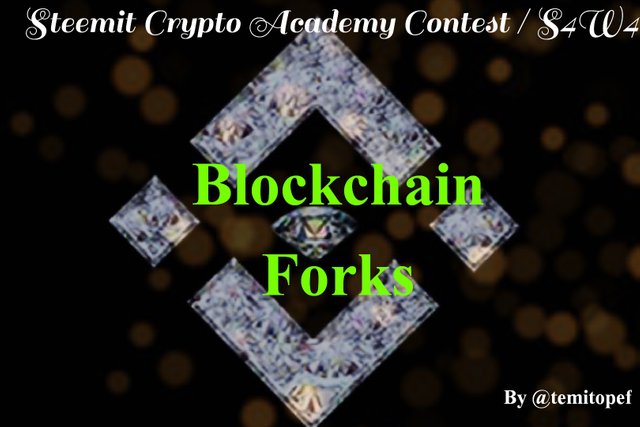
Cover Image Created using PosterMaker
Dear Steemians, I'm very happy to write in the academy again for this week in the last week of the challenge season 4. The title of this beautiful contest is "Blockchain Forks". Go with me as I discuss this beautiful contest my friends.
Using your own terms to define what is a fork in general?
Blockchain also has forks like our kitchens, the first time I heard this, I was surprised and very inquisitive about what it is, they are different forks when I read about it further. Blockchain forks is a special event in a blockchain that happens when it needs to change the protocol of how it works to make the blockchain network more friendly to everyone or to improve some things about the blockchain.
Furthermore, blockchain forks can happen when the people in charge of a blockchain like developers want to implement new rules, and methods of transaction validation, increase the block size of the blockchain, and many others. You know that our transactions are stored in blocks on the blockchain and there is a limit to the amount one can handle at a time so there may be a need to increase the size for scalability reasons.

Blockchain forks
Blockchain forks can be soft fork or hard fork, any type of this largely depends on the agreement between the developers and those who secure the blockchain network (miners) and even other nodes. So the fork can have no objection by any of the parties and sometimes, the fork can happen when they are no agreement throughout the blockchain network, I will explain the two types of blockchain forks later in this post.
Why Forks Happen in the Crypto Space
Using any blockchain example, explain what a Hard Fork is
I said it before that I would explain the types of blockchain forks that we have in the crypto space and I will do that before I answer the question they asked us in this part of the contest. Hard forks are the types of forks that happens as a result of a disagreement between the developers and stakeholders of a blockchain network.
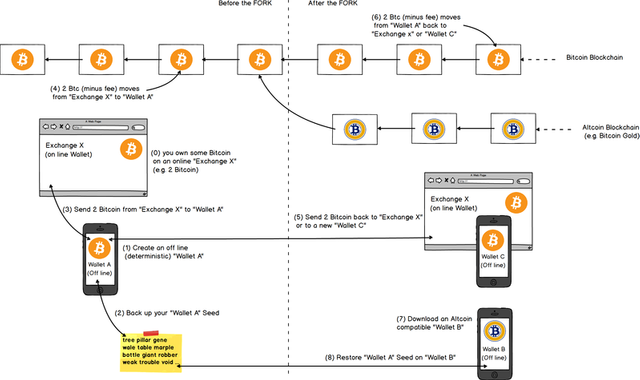
Demonstration of hard fork
Furthermore, hard forks mean that the stakeholders and developers of the blockchain do not agree with changes or upgrade that are proposed which results in a hard fork, that is two different chains are formed, a new one is formed here because there is no total agreement between everyone on the network. This always leads to the creation of a new token.
Bitcoin Blockchain Hard Fork- Bitcoin Cash
When I research this, I realized that there have been some hard forks on the Bitcoin blockchain which led to another blockchain network after the Genesis block. The first hard fork on the Bitcoin blockchain was Bitcoin XT in 2014, proposed by Mike Hearn to increase the block size of the Bitcoin network from 1 Megabye to 8 Megabytes. Also, it was aimed to process 24 transactions per second from 7 transactions per second that it was at that time.
This led to a hard fork with a new chain creation, the new network was adopted by some nodes but it later died off. Now, Bitcoin Cash, this is the second hard fork on the Bitcoin network that happened in 2017. Bitcoin cash was aimed to increase the block size of the network to just 2 Megabytes, the research shows that the new fork received interest from several nodes in those months.
Furthermore, Bitcoin Cash hard fork didn't die off like XT and this means that the chain is still lively and used today. BCH (Bitcoin Cash) is the token that was formed through this hard fork which is trading around $110.52 and has a market capitalization of $2,121,826,304 which makes it ranked 30 in the crypto space.
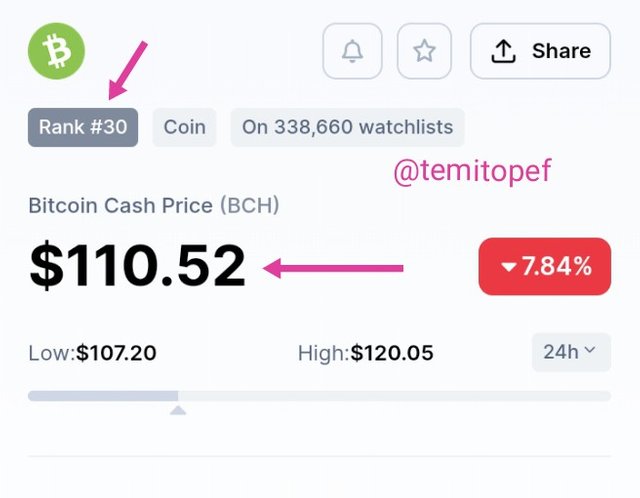
Screenshot of Bitcoin Cash on Coinmarketcap
The circulating supply of Bitcoin Cash at the time I was writing my post is 19,177,881.25 BCH and that's about 91% of the total supply of this token. So, Bitcoin Cash is an example of a hard fork on the Bitcoin blockchain.
Using any blockchain example, explain what a Soft Fork is.
Before I continue with this also, let me explain what soft fork is all about. Soft fork in the blockchain can be defined as a fork that happens as a result of a software upgrade, this is not in any way create a separate chain from the old one, only some changes were made to the system and any node in a network can upgrade.
Furthermore, Soft fork is also said to be backward-compatible and what this means is that the upgraded node can still communicate with the old nodes that have not undergone an upgrade without breaking the protocol of a network. So, the nodes in the network will still process transactions on the blockchain network only some transactions that don't align with the rules of a node would be rejected.
Bitcoin Blockchain Soft Fork- SegWit (Segregated Witness)
SegWit is a soft fork that happened on the Bitcoin blockchain after the hard fork that brought the creation of a new chain for Bitcoin Cash. SegWit is a soft fork in the sense that the upgrade is optional for the nodes on the network, anyone can upgrade or not, and it doesn't affect their participation in the network.
When I was reading this, I thought to myself that since block size was one of the reasons for the BCH split, they decided to give an option for block size increase through SegWit.
Segregated witness upgrade was designed such that there will be increased speed of transaction on the Bitcoin blockchain, this will help to reduce the occurrence of delayed transactions. With a segregated witness, the witness data is separated from the transaction data which frees more space for more transactions to be added to the block on the Bitcoin network.
Furthermore, the block weight limit of the node that has not upgraded to SegWit has 1 Weight Unit (WU) while the node that has upgraded to SegWit has a block weight limit of 4 Weight Units (WU). This means that the SegWit block holds more transactions than the older system which makes way for a more scalable Bitcoin network.
An upgraded node to SegWit can still handle transactions on the old nodes as long as the transaction satisfies both the old and new rules, for example, a transaction in a block not up 1 WU from an old node on the SegWit node, this is why they said that it is backward-compatible. SegWit is a soft fork because the upgrade did not affect the network to create separate chains, it's a matter of choice.
What are the differences between Hard Forks and Soft Forks?
| Hard Forks | Soft Forks |
|---|---|
| The change causes a forced split in the network to form two chains, old and a new one. | The changes are just like a software upgrade that does not cause any split. |
| It's not backward-compatible, the two chains work separately. | It's backward compatible. |
| No total agreement on the network and that creates a divided community. | There is an agreement across the network which makes the upgrade optional and doesn't create a divide among the community. |
| New tokens are created from the newly formed chain and it's different from the old token. | No creation of a new token with soft forks. |
Explain the Steem and Hive Hard fork by showing the similarities/differences in their Genesis blocks
I have heard of Hive so many times that it was a hard fork of Steem but this contest has helped me to research the fork. According to research, the hard fork on the Steem blockchain that led to a new community, Hive, happened on March 20, 2020.
You know that a hard fork in the blockchain is always a result of no agreement among everyone on the blockchain about some rules or development which I guess the same happened in the case of the Steem blockchain hard fork. I read that during the hard fork, Hive tokens were airdropped to all Steem holders in the ratio of 1:1.
Back to the question, the question said we should explain Steem and Hive's hard fork by explaining the similarities/differences in their genesis blocks. So, what is the Genesis block? Genesis block refers to the first ever mined block on a cryptocurrency blockchain.
As an example, the genesis block of the Bitcoin blockchain network was mined on the 3rd of January 2009 and its transaction hash is https://www.blockchain.com/btc/block/000000000019d6689c085ae165831e934ff763ae46a2a6c172b3f1b60a8ce26f.
Furthermore, one thing is that after the hard fork, the two chains both old and new will have the same genesis block, only the new blocks produced after separation will be different, I will prove it later below. The genesis block can be named Block 0 or Block 1.
The Similarities
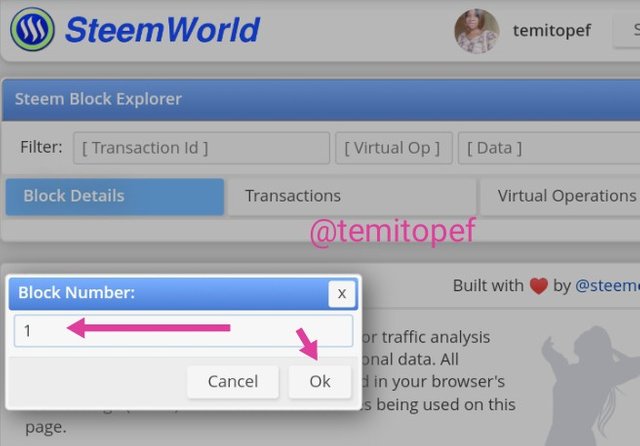
Screenshot from Steemworld
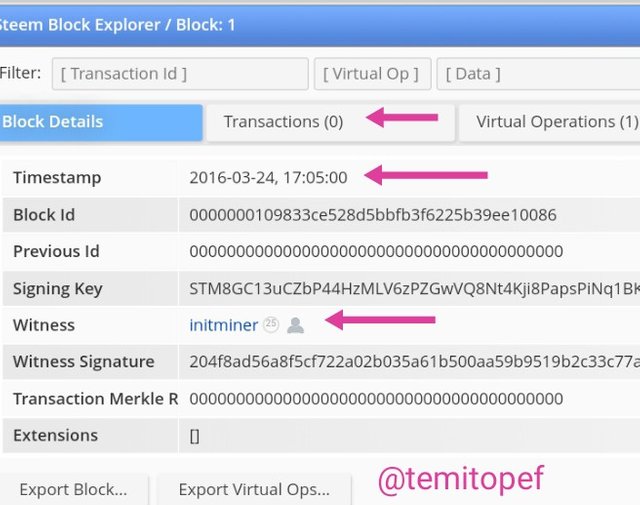
Screenshot from Steemworld
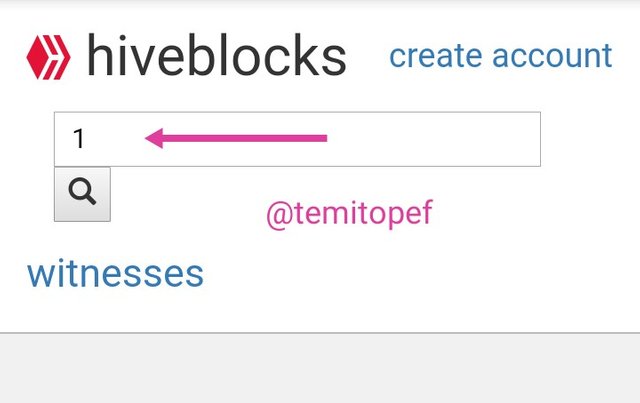
Screenshot from Hiveblocks
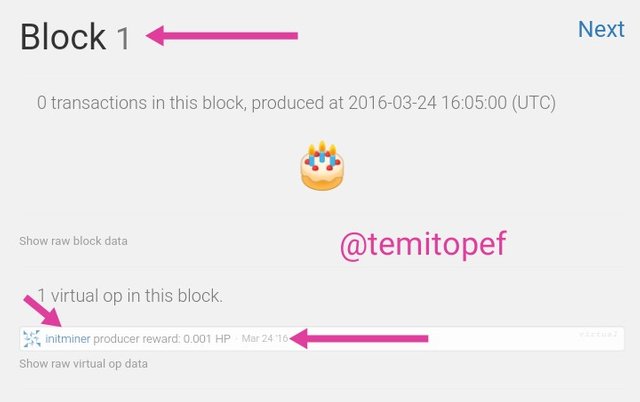
Screenshot from Hiveblocks
The examples I have explained above show that the Genesis blocks of both Steem and Hive are the same. So the similarities are that they are mined on the same day, at the same time (16:05 UTC), 0 transaction, by the same miner and signature, and same origin hash.
Their new blocks after the hard fork changes and each chain maintain its own transaction data. The only difference in the Genesis block is the block reward which is 1.000000 VESTS for Steem and 0.001 HP for Hive but that has no serious significance. The genesis block is similar for both blockchains even after the hard fork.
Furthermore, to see that the new blocks are different, I chose block 61,000,000 for both Steem and Hive. The block on Steem has 31 transactions and mined on January 24, 2022 by @steemchiller and the block on Hive has 86 transactions, mined on January 17, 2022. So, the genesis block is the same while new chains are different.
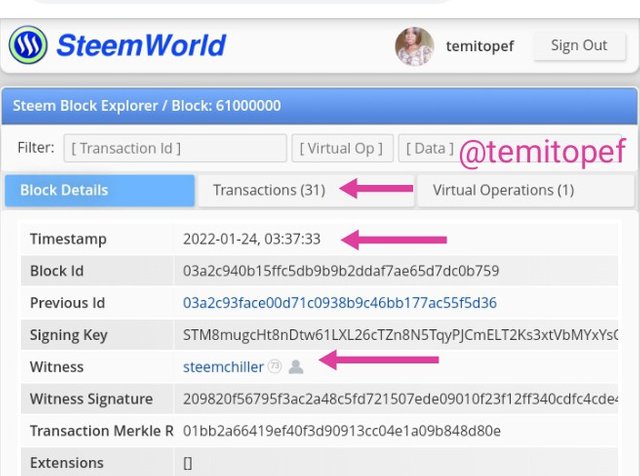
Block 61000000 on Steem
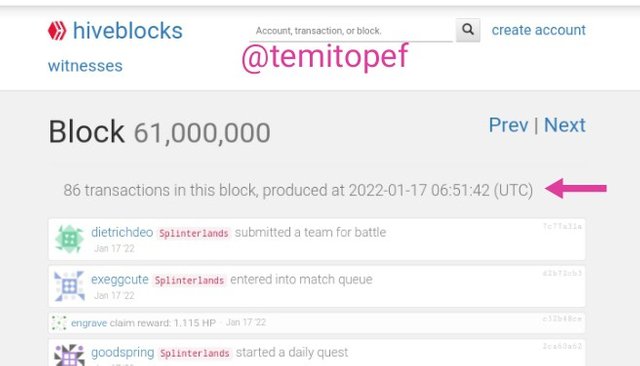
Block 61000000 on Hive
Conclusion
Blockchain forks are very important things to know in the crypto space, they happened as a result of making changes to protocol which could result in hard or soft forks and that depends on the agreement between the developers, miners, and the community. Hard forks cause split while soft forks remained one and it is backward-compatible.
Furthermore, I was able to see the practical by myself of how Steem and Hive have the same Genesis block after the hard fork. Thanks to the academy for this beautiful contest topic, it really put my brain to the test. This is where I will be stopping for now.
Wow
Learnt a lot about hard fork and soft fork, didn't know much about this terms before now, Thanks for this🔥
I'm glad you can understand more about hard and soft forks. Thank you for reading.
Thank you for sharing this educative post. I was really pleased in your explanation of the steem and give hard forks you explained and displayed pictures as well good work.
Thank you for reading, I'm glad you like it.
Blockchain forks are divided into two, namely hard forks and soft forks. Hard fork occurs because of changes that are not compatible with the previous version. While the software changes that are compatible with the old version and can still communicate with the old version.
I also share about blockchain Fork, if you have time please take a look and I'm very happy.
Yes you are right . One more aspect of security is that at times reversal of transactions is carried out to reallocate the funds in case of hacks
That's true . Moroerver the new blockchain formed also launches a new token . The token holders of old blockchain are issued same number of tokens on new blockchain too.
You have explained every point in great detail. I wish you good luck for this contest.
Your way of seeing things and putting them into writing just keeps amazing me every blessed day and I don't want to stop.
Your explanations were direct and on point. For a second I thought you were a crypto professor.
Good luck my dear.. I wish you all the best.
Your explanation about the Blockchain Forking is very much impressive. You have a good knowledge of the Blockchain Forking. Forking could be done when a new proposal is given by a developer to improve the features or the working system of a blockchain.
Yes, you are right here friend. By increasing the block size of a blockchain, the capacity of a block to store more and more transactions is increased and hence the scalability is increased.
Thank you very much for sharing your precious post with us and I wish you a very happy contest ahead.
Definitely dear they are expected to have similar things in common because steemit is like the parent fork while hive is the child fork, just humans do child forks always inherit features from their parents.
Thank you very much for sharing, please you can check my own entry here
wishing you success